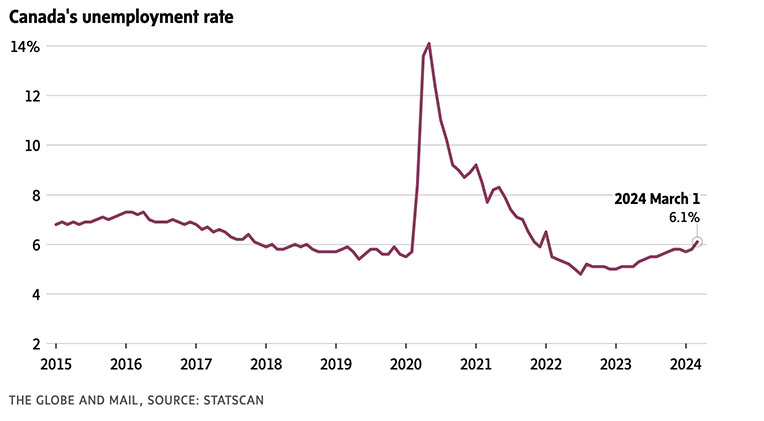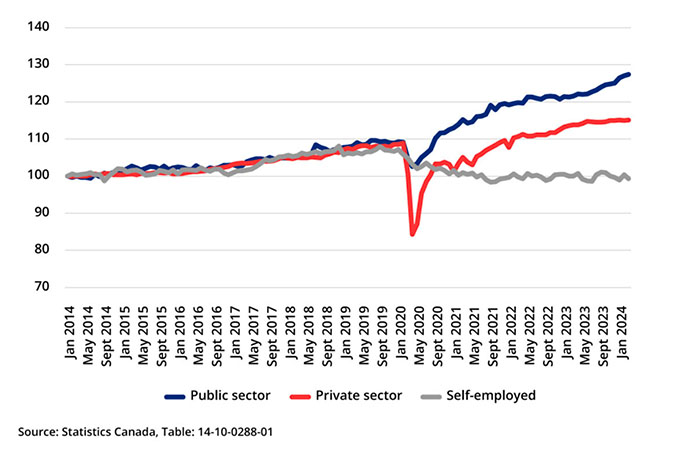Imagine waking up in Canada one morning and finding out that you no longer have a job. A rush of anxiety washes over you as you realize you have to pay down your extravagant mortgage in country which has policies hurting it’s middle class. Well, that’s what happened to Jane, a 35-year-old mother of two who worked as a producer at Bell Media for a popular radio show in Toronto.
She was one of the 5000 workers who were laid off by Bell Media in February 2024.

Jane is now struggling to find another job in the media industry, which has been hit hard by various factors.
Sadly, Jane’s story is not unique. Layoffs in Canada have been exploding since last year, affecting workers from all sectors and regions of the country. But what are the causes and consequences of these layoffs? Keep reading and we will explore what’s behind these tricky financial times in Canada.
2023 and 2024 was a Rough Year for Layoffs in Canada
The year 2023 was marked by a series of mass layoffs in Canada that affected workers from various sectors and regions in Canada. Some of the major companies that announced layoffs in 2023 were:

- Air Canada which cut 20,000 jobs, or more than half of its workforce, due to the collapse of the travel industry amid the pandemic and the border restrictions.
- Bombardier which eliminated 2500 jobs in its aviation division as part of its restructuring plan to reduce its debt and focus on its core business.
- Cineplex, which laid off 130 full-time employees and reduced the hours of 10,000 part-time workers as a result of the prolonged closure of movie theatres and the decline in box office revenues.
- Suncor, which slashed 2000 jobs or 15% of its total staff, as a response to the low oil prices and the weak demand for energy products.
These layoffs had a significant impact on Canadian workers and the economy, as they reduced the income, spending, and tax contributions of the affected workers, as well as the productivity, profitability, and competitiveness of the affected businesses. They also are continuing to contribute to a general malaise of living in Canada as emigration rates skyrocket due to Canadians looking for better job opportunities abroad.
Moreover, these layoffs occurred at a time when the Canadian economy was experiencing a paradoxical situation of a job surge and a labour shortage.
According to Statistics Canada, the unemployment rate in Canada dropped to 5.4% in November 2023, the lowest level since 1976. At the same time, the labour demand in Canada reached a record high of 6.9 million job vacancies in the same month. While those numbers seem average and might signal a recovery in Canadan labour, by looking at the data 6 months later in March of 2024 we see that Canada’s average unemployment jumped to 6.1% with young Canadians mostly out of a job.

This situation created a challenge for both employers and workers, as it increased the pressure on wages, prices, and interest rates. These unemployment numbers are likely lower than reality as they don’t count people on EI who are actively looking for work. This is also reflected by the massive lines for entry level jobs seen around the country.
2024 is not Looking Better for Less Layoffs in Canada
If you though 2023 was bad, 2024 did not bring any relief to the Canadian workers who were hoping for a better future after 2023’s job cuts. Instead, it brought more bad news, as one of the largest and most influential media companies in Canada, Bell Media (as we mentioned earlier) announced that it was cutting 5000 jobs and shutting down many Canadian programs and radio stations.
This decision was met with outrage and disbelief by the workers, the consumers, and the public, who accused the company of being greedy and hypocritical.
Bell Media claimed that the layoffs were necessary to “adapt to the changing media landscape” and to remain competitive in the market. The company also said that it was facing challenges from the shift to digital platforms, the competition from streaming services, and the decline in advertising revenues.

However, many critics pointed out that the company had received millions of dollars in government subsidies and reported high revenues and profits in the previous year.
They argued that the company was using the pandemic as an excuse to cut costs and increase profits while sacrificing the quality and diversity of Canadian media content.
The impact of the Bell Media layoffs was felt not only by the workers who lost their jobs but also by the Canadian economy and society who are right now actively being squeezed by all angles from Canada’s monopolies.
Broader layoffs in Canada resulted in a loss of income, spending, and tax contributions of the affected workers, as well as a loss of productivity, profitability, and competitiveness of the affected businesses.
The layoffs also undermined the diversity and quality of Canadian media content, as well as the public interest and trust in journalism. The closure of many Canadian programs and radio stations and programming, such as TSN Radio, MuchMusic, and my personal favourite, BNN Bloomberg which has eroded the Canadian identity and culture, as well as the access to local news and information.
Even Self-employed are Not Safe in Canada’s Labour Market
Another troubling trend that emerged in the Canadian labour market was the decline of self-employment. Self-employment can offer many benefits, such as flexibility, autonomy, creativity, and satisfaction. However, it can also entail many challenges, such as uncertainty, risk, isolation, and lack of support.

According to the latest data from the Labour Force Survey, the number of self-employed workers in Canada decreased by 1.4% in January 2024 compared to the same month in 2023. The self-employment rate, which is the proportion of self-employed workers among the total employed population, also dropped to 14.7%, the lowest level since 2016.
The decline of self-employment in Canada can be attributed to various factors, such as the aging population, the economic downturn, technological change, and regulatory barriers. A study by the Fraser Institute found that self-employment in Canada has been decreasing since 2000 due to the following reasons:
- Aging Population: The increasing number of older workers, who are more likely to be self-employed, decreases as they retire or leave the labour market, reducing the pool of self-employed individuals.
- Economic Downturn: The pandemic-induced recession has cut demand and opportunities for self-employed workers, particularly in the service sector, leading many to lose business and seek other employment.
- Technological Change: While technology has opened new opportunities for self-employed individuals by enabling remote work and access to new markets, it also brings increased competition and operational complexities, sometimes displacing traditional self-employed roles.
- Regulatory Barriers: Canada’s regulatory environment poses challenges for self-employed workers, including limited access to social benefits, financing, training, and insufficient protection and recognition of their rights.
Understanding why Layoffs in Canada Are Happening Like Crazy Now
The outlook of the Canadian labour market in 2024 is not very optimistic according to numerous projections of economists and analysts.
The general consensus is that there will be more demand for jobs than jobs available. Canadian economists also expect that the trend of layoffs and the decline of self-employment will continue as the power balance between workers and employers shifts stronger to the latter, making it harder for workers to negotiate fair wages, benefits, and working conditions.
In our research, the factors that are influencing layoffs in Canada in 2024 are:
Reason 1. Higher for Longer Interest Rates increasing Layoffs in Canada
In March 6th, 2024, the Bank of Canada kept it’s overnight interest rate at 5 and 1/4 percent. Rates this high are used to decelerate as the Canadian economy in an attempt to cool inflation and our hot housing market. With in this range, businesses are more leery of borrowing money to grow their enterprises. In turn, many businesses will ‘tighten’ their wallets by shutting down growth projects and cutting employee numbers and even halting hiring which most unemployed Canadians are currently experiencing.
Reason 2. Increased Worker Productivity and Lower White-Collar Demand:
With the mainstream adoption of Artificial Intelligence into the workforce, employees are now much more productive than ever before. Instead of hiring a team of writers for your magazine you can now hire 1 writer with a Chat GPT subscription to help pump out articles at a massive scale. Sadly this is making a lot of jobs redundant hence the mass layoffs in the sector we see today.
Reason 3. Major Cut Backs in Consumer Spending
The dirty little secret of 2024 is that if you subtract the growth of Canada’s foreign population, Canada’s GDP is actually in decline. In fact, it’s been like this for a few quarters meaning we are in a technical recession like our Japanese and German counterparts. Organizations realize this, and are preemptivley protecting their pockets by cutting expensive employees from payroll before a low sales quota hits the books.
These factors will have different implications for different sectors, occupations, and regions in Canada.
- Sectors like healthcare, education, and technology will face high demand and limited labour supply, empowering workers with increased bargaining power. Occupations such as nurses, teachers, and software developers will offer competitive wages and benefits, attracting skilled workers. And regions such as Ontario, Quebec, and British Columbia will experience robust job growth and low unemployment rates, making them appealing to workers.
- Conversely, sectors like retail, hospitality, and manufacturing may encounter low demand and surplus labour, granting employers more negotiating power. Occupations such as salespersons, servers, and factory workers might see lower wages and limited opportunities, posing challenges for workers. And regions like Alberta, Saskatchewan, Newfoundland, and Labrador may struggle with low job growth and higher unemployment rates, presenting disadvantages for workers.
What can you do to Survive Layoffs in Canada?
If you are looking for a better job opportunity and a better quality of life, you may want to consider the following options:
- If you are planning to come to Canada, you should reconsider your decision to move at this time unless your field is in high demand. According to CanadaWiz’s data, some of the most in-demand jobs in Canada in 2024 are Nurse, human resources manager, electrical engineer, veterinarian, and pharmacist. However, these jobs may also face high competition and low wages, as well as strict visa and immigration requirements.
- If you are already living in Canada, you can always look to emigrate to a country that has a lower cost of living and a better job market than Canada. According to Numbeo’s data, some of the cheapest countries to live in 2024 are Egypt, Ukraine, Sudan, and Kyrgyzstan. According to U.S. News data, some of the countries that have the best job markets in 2024 are Singapore, Switzerland, Germany, and Japan. You can also check out your Leaving Canada Guide below to help ensure your smooth extended ‘vacation’ from Canada here:

Explore Your Opportunities Abroad
Use the Canadian Exit Guide to see how you can leave Canada to find better opportunities abroad.
Now, if you are not sure which country is the best fit for you, you can take our Leaving Canada Country Quiz below which will help match you to the best destination based on 22 of your preferences.
It will then take you to a page with useful information and resources to help you understand if the country is one which you can live out your Canadian dream in.
So, what are you waiting for? While layoffs in Canada are exploding, weather out the storm in a new haven today:
Looking to leave Canada?
Take the country quiz to see where you belong!


Leave a Reply